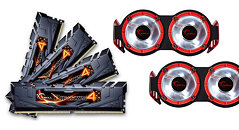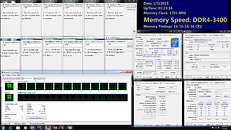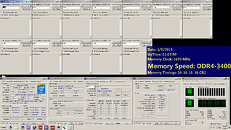Thursday, January 15th 2015

G.SKILL Releases Extremely High End DDR4 Memory Kit at 3400MHz
G.SKILL International Co. Ltd., the world's leading manufacturer of extreme performance memory and solid-state storage, is proud to release the Ripjaws 4 DDR4 3400MHz 16GB (4GBx4) memory kit at CL 16-16-16-36, and a new Ripjaws 4 DDR4 3200MHz 16GB (4GBx4) memory kit with a faster CL15 timing. These extremely high end memory kits also come with awesome Turbulence III memory fans.
The new Ripjaws 4 DDR4 3400MHz 16GB (4GBx4) memory kit is made from hand-picked IC and G.SKILL's highly-selective binning process. It has also been tested for compatibility on the Asus Rampage V Extreme and Gigabyte X99-SOC Champion motherboards, shown in screenshots below.Established in 1989 by PC hardware enthusiasts, G.SKILL specializes in high performance memory and SSD products, designed for PC gamers and enthusiasts around the world. Combining technical innovation and rock solid quality through our in-house testing lab and talented R&D team, G.SKILL continues to create record-breaking memory for each generation of hardware and hold the no. 1 brand title in overclocking memory.
The new Ripjaws 4 DDR4 3400MHz 16GB (4GBx4) memory kit is made from hand-picked IC and G.SKILL's highly-selective binning process. It has also been tested for compatibility on the Asus Rampage V Extreme and Gigabyte X99-SOC Champion motherboards, shown in screenshots below.Established in 1989 by PC hardware enthusiasts, G.SKILL specializes in high performance memory and SSD products, designed for PC gamers and enthusiasts around the world. Combining technical innovation and rock solid quality through our in-house testing lab and talented R&D team, G.SKILL continues to create record-breaking memory for each generation of hardware and hold the no. 1 brand title in overclocking memory.




12 Comments on G.SKILL Releases Extremely High End DDR4 Memory Kit at 3400MHz
Back in the old days of DDR1, 400MHz was pretty much the standard speed for that generation. DDR2, it was 800MHz, DDR3, 1600 (or maybe 1333, not sure). Am I silly to expect that when DDR4 reaches maturity that the standard speed for the platform will eventually be 3200MHz with average timings? Or is that wishful thinking?
Most people have never taken the time to educate themselves on DRAM or system performance changes based on DRAM changes. Up until DDR3 came along the CPU/system could generate/process data faster than the DRAM so DDR and DDR2 were system bottlenecks. As such frequency and timings could make a noticeable change in system performance. With the advent of DDR3 the situation started to change as DDR3 running at 1600 MHz. or faster eliminated the DRAM bottleneck that previously existed. As a result even with the fastest CPU powered desktops and DDR3 RAM running at 1600 MHz. there is no tangible system performance gains with increased frequency or faster timings as these aspects become minute changes for a system that is no longer bottlenecked. APU powered systems can gain a small performance boost from RAM up to 2133 MHz. Above that you're just throwing money away.
DDR4 which is actually designed primarily for servers, it a solution to a non-existent problem at this point in time. LV DDR3 can provide essentially the same performance at a considerably lower cost. In addition with DDR4 the topology is different so you can't add to existing DRAM you must replace it all if you desire increased capacity. Naturally those who don't bother to do their homework can easily be duped into believing that they will see a system performance advantage by upgrading to DDR4, when it reality this is not true for CPU power desktop systems running 1600 MHz. or higher RAM frequency and 2133 MHz. for APU powered systems.
BUT GKSILL has its best overclocks past years and still they are the best overclockers in RAM. i remember RJ 1600mhz speed ram CL7, can easily go to 2133mhz with maximum loosen timings to CL9 the performance was better than RJ X 2400mhz cl11. it was just GREAT to compare.
With respect to memory speeds, I have 2133Mhz memory and it's significantly faster than 1600Mhz memory. The problem is that most CPUs and applications don't need it or can't use it. 2400 CL10 versus 2133 CL9 is measurably faster, bandwidth wise and latency drops almost 4-5ns. Once again, most computers and applications can't actually utilize it, so it really means nothing.
tridentX seems faster even with higher CAS. no doubt 2133mhz faster than 1600mhz in any comparison. but these comparison are only limited to Benchmarking. otherwise gaming doesn't suppose to make any real difference at all.
andyou got good RAM 2133 @CL9 is not easily available. most are CL10 or CL11.
Tighter the Timings, better performance would be. we can only get 1600/1866mhz with lower/Good timings. i usually do overclocking and benching so i tried many different rams with different CAS.